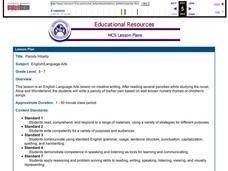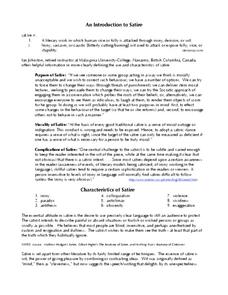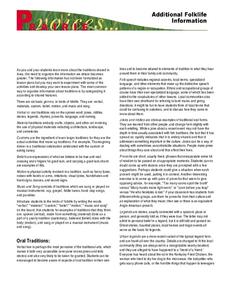Curated OER
Parody Hilarity
Upper grade and middle school writers study the art of parody. In this language arts lesson, learners study the work of Lewis Carroll, read and discuss parodies from the book, Alice in Wonderland, and construct their own parody based on...
Curated OER
Shakespearean Comedy on Film
This lesson plan will focus on the aspects of Shakespeare's comedy that become more evident in performance. By viewing clips of the same Shakespeare scene in different film versions, high schoolers have the opportunity to engage in a...
Texas Education Agency (TEA)
Drawing Conclusions Based on the Sufficiency and Strength of Research (English III Reading)
High school juniors learn how to construct a strong argument by crafting a claim and using neutral language backed by evidence from reliable sources. To do so, they learn to evaluate sources and evidence to support claims. They then...
University of British Columbia
Pondering Poetry and Playing with Words
First-year High school scholars explore the world of poetry with an 11-lesson unit that examines a range of poetry forms and tries their hand at crafting their own poems. Young poets then collect their work in a portfolio that they...
University of Wisconsin
Don Quixote in Wisconsin
Are you looking for background information on Cervantes and his Don Quixote? How about a study guide and discussion questions or project ideas? Even journal prompts, tests, and quizzes? A 98-page teaching guide simplifies the quest with...
PBS
Satire, Parody, and Humor in Catch-22
Laughter is the heart of dark comedy. It makes the unbearable bearable. Joseph Heller crafted his dark comedy Catch-22 to enable readers to laugh at the painful realities and underscore the absurdities of a war where people you...
Poetry4kids
How to Write a Silly Song Parody
Imitation is the sincerest form of flattery—and it's a great way to learn about poetic structure! Young poets use familiar tunes to write a song parody based on straightforward guidelines.
Chandler Unified School District
Satire: The Art of Indirect Persuasion
A free press is entitled to its opinions. While the news pages report the facts of events, editorial pages feature writers' and cartoonists' opinions about events to either directly or indirectly persuade. Introduce viewers to the art of...
Jackson School District
An Introduction to Satire
What is satire, and what are its characteristics? A handy handout provides young satirists with all the information they need to analyze a satire or to craft their own.
University of Northern Iowa
Additional Folklife Information
Use a packet packed with ideas for how to celebrate the traditions of your country, state, community, and pupils's families. Suggestions for how to draw on oral and material traditions, customs, beliefs, music, and stories all find...
Curated OER
Satire
The bite of comedy often rests on use of the literary devices detailed in this presentation. The definitions for terms like sarcasm, zeugma, and invective are followed by examples drawn from literature. Consider extending the lesson by...
Curated OER
Portrait Parody
Eighth graders use modern materials and technology to create a modern portrait modeled after a Renaissance picture.
Curated OER
Marketing to Teens: Parody Ads
High schoolers deconstruct advertising messages by analyzing parody ads and exploring the purpose of satire. Then they create their own parodies based on real ads discussed in class. A creative activity to extend any study of media,...
Curated OER
My Blackberry Isn't Working
This activity starts out on a strong note by using a humorous video called "My Blackberry Is Not Working" from BBC One to teach parody. While they watch the short video, viewers fill out a chart about the electronic brands, noting any...
Curated OER
Impersonating Great Poets Using "Science Verse" by Jon Scieszka
A great way to bring poetry and parody into your language arts classroom, this instructional activity mimics famous poems based on Jon Scieszka's Science Verse. The activity not only allows the class to see examples of poem parodies, but...
Curated OER
Poetry
Explore the semantics of poetry with this higher-level presentation. With examples from Dickinson, Frost, and Dr. Seuss, the slides clearly explain the details of poetic structure, license, and schemes. You could use this in a language...
Curated OER
Parody
Expand your students' literary likings with this quick PowerPoint about parodies. A detailed definition of a parody on the second slide precedes different examples of parodies in pop culture. Tip: Show videos of famous parodies your...
Curated OER
Cartoons for the Classroom: A Parody of Broken Promises
Parodies of political figures are the lifeblood of the editorial cartoons in a free press. North Korea's nuclear threat provides young political scientists an opportunity to hone their critical thinking skills as they analyze a...
Curated OER
Satire in Fiction
Twelfth graders identify satire in various fictional texts. In this language arts activity, 12th graders will learn to define satire, parody, and caricature. Students will identify different forms of satire in historical and...
Curated OER
Parodies of Shakespeare
Students view a video clip about parodies. They identify the characteristics of a parody in Mark Twain's work as well. They practice writing Shakepeare like verses.
Curated OER
Funny Business
Students discuss how much they understand of satire and parody. They read an article about an Iraq news parody show. They create and act out their own parody skit. They write an essay about using humor in grave situations.
Curated OER
Tee-Hee T.V.
Students examine the concept of satire by reading lyrics to a song and reading "Soap and the Campus: A Web-Site Spoof Succeeds." They create treatments for parodies based on current television shows.
Curated OER
Satire: A Matter of Tone
Satire, anyone? After a review of terms associated with satire, viewers are directed to craft a 500-600 word piece of satire about a familiar hypocrisy.
Curated OER
Deciphering the Mechanics of Poetry
Eighth graders analyze a variety of poems to develop the ability to recognize and explain a variety pf poetic devises.























